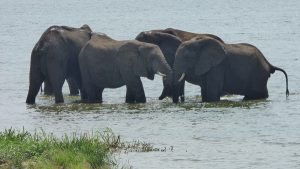
Elephants are arguably the second icon of the African safari, after the Lion of course. The biggest land mammal is unmistakable in the African bush; a gigantic dark grey structure with pillar-like legs, large ears and a long trunk, gracefully strolling through the plains is one of the most beautiful sights of the safari.
Other than the intriguing structure of the elephant that you can’t get enough of, there is so much to learn about the elephant and its critical importance to the environment. For example, the elephant is regarded as the chief architect of the savanna whose constant felling of trees prevents the growth of the forest hence maintaining a savannah where other herbivores and cats can flourish.
Also, did you know that humans developed soft feet when they came down from the trees and learned to walk was only made possible by the elephants that made the ground soft on which man could walk…?
You may also want to see the Elephant simply because it is a member of the famed “Big Five”.
The elephant is therefore one of the animals not miss on the safari trip and Uganda is one of the places that still have a healthy population of elephants.
Elephant species in Uganda
There are two species of elephants that are present in Uganda, that is; the African bush elephant (or African savannah elephant), and the Forest elephant.
The African bush elephant is the most prominent elephant species in Uganda that is easily found in a number of parks across Uganda.
The forest elephant is a rare one to find and inhabits some of the forest parks in Uganda such as Bwindi forest. The forest elephant presence in Uganda has however been refuted by some who claim these elephants in the forest are not necessary forest elephant species but simply remnants of the Africa bush elephant.
What is the population of elephants in Uganda?
Uganda is one of the few places in Africa where the elephant population has had a steady increase in the recent past.
As of 2020 the population of elephants in Uganda was put at 7975, an increase from 5808 in 2017 which was also an increase from 5730 individuals in 2014. This is according to the Uganda Wildlife Authority, an organization tasked with managing the parks in Uganda.
Places to the see elephants on safari in Uganda
Queen Elizabeth National Park
Queen Elizabeth protected area (which includes Queen Elizabeth National Park, Kyambura Wildlife Reserve and Kigezi Widlife Reserve) has the biggest population of elephants in Uganda which the last census carried out in 2018 put the figure to 3953 elephants.
On a good day you will have the best elephant experience in Queen Elizabeth National Park. I say on a good day because this park is linked with the Virunga National Park of the neighboring Democratic of Congo and there are seasonal movements of herds of elephants from one park to the other.
Never the less, Queen Elizabeth National Park is one of the best places to see elephants in Uganda. The Kasenyi plains, Mweya peninsula and the remote Ishasha plains near the Congo are areas you won’t miss an elephant sighting while on a safari drive. For even better sightings of elephants the Kazinga Channel offers up close views while on a boat cruise safari as the elephants come to quench their thirst and cool off the afternoon heat. The Kazinga Channel boat cruise actually offers some of the closest encounters you will ever have with an African bush elephant without compromising your safety.

Elephants in the Kazinga Channel
Murchison Falls National Park
Murchison Falls National Park, Uganda’s biggest park, is another place in Uganda that will give you wonderful sightings of elephants in Uganda. The population of elephants in the conservation area (which includes the park and surrounding reserves) as of 2019 was 2726.
Elephants in Murchison Falls National Park are best seen during the safari drive in the savannah which is on the northern bank of the River Nile.
The afternoon boat cruise on the Nile River also offers great views of the elephants along the river bank where they come to drink and cool off.
Kidepo Valley National Park
The remote rugged Karamoja plains in the Kidepo Valley National Park host a relatively small population of elephants that was counted to be 295 in 2019, this is in addition to the incredible herds of buffalo for which the park is famous. Kidepo is an incredibly beautiful safari destination located in the north eastern corner of Uganda, way off the popular tourist circuit.
Given the long distance to the park and a small elephant population, may be you should travel to Kidepo if you are looking for more than just elephants.
Karenga Community Wildlife Area
Karenga Community Wildlife Area is like an extension of Kidepo Valley National Park. The wildlife area has a population of 351 elephants sighted in 2019. Elephants tend to migrate between Kidepo and Karenga which is sometimes the reason for the few elephants in Kidepo National Park.
Kibale National Park
Kibale Forest National Park, a famous primate capital mostly known for the chimpanzee trekking is one of the forests you easily come by elephants too. The last elephant census of 2019 put the population of elephants in Kibale National Park at 566 individuals which is quite impressive for a largely forest park.
However since activities in Kibale forest are done on foot, it is never safe to meet the elephant along your trail. Therefore you do not go looking for elephants in Kibale forest but you stand a chance of seeing them during the activities in the forest.
Bwindi Forest National Park
Bwindi forest has elephants that are thought to be forest elephants. Bwindi forest is popular for the gorilla trekking adventures and along your trek to see gorillas you may bump into a lone elephant or see traces of elephants such as foot prints, dung and fallen trees. The last census of elephants in 2019 put the elephant population at 106 individuals
Rwenzori Mountains National Park
The Rwenzori mountain ranges varied habitats include forest that harbors among other wildlife elephants. The Rwenzoris has a tiny population of elephants that the census carried in 2019 puts at just 13 individuals. The elephants in the Rwenzoris have been the most vulnerable due to the long insurgencies in the region that rendered the park hard to protect thus exposing it to a lot of poaching.
You therefore may be lucky to spot an elephant on the hiking trip in the Rwenzori.
Leave a comment Cancel reply
Archives
- June 2025 (1)
- March 2025 (1)
- February 2025 (1)
- January 2025 (1)
- November 2024 (2)
- October 2024 (3)
- May 2024 (1)
- February 2024 (1)
- January 2024 (2)
- November 2023 (2)
- September 2023 (1)
- July 2023 (8)
- June 2023 (14)
- May 2023 (1)
- April 2023 (1)
- March 2023 (3)
- February 2023 (6)
- January 2023 (6)
- December 2022 (1)
- November 2022 (1)
- October 2022 (2)
- September 2022 (1)
- August 2022 (1)
- May 2022 (17)
- April 2022 (5)
- March 2022 (7)
- February 2022 (3)
- January 2022 (7)
- December 2021 (7)
- November 2021 (2)
- October 2021 (1)
- September 2021 (2)
- August 2021 (2)
- July 2021 (6)
- June 2021 (1)
- May 2021 (4)
- April 2021 (3)
- March 2021 (2)
- February 2021 (2)
- January 2021 (14)
- November 2020 (2)
- September 2020 (1)
- March 2020 (1)
- February 2020 (1)
- August 2019 (1)
- September 2016 (1)
- June 2016 (1)
- May 2016 (1)

